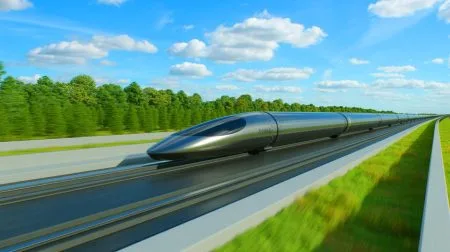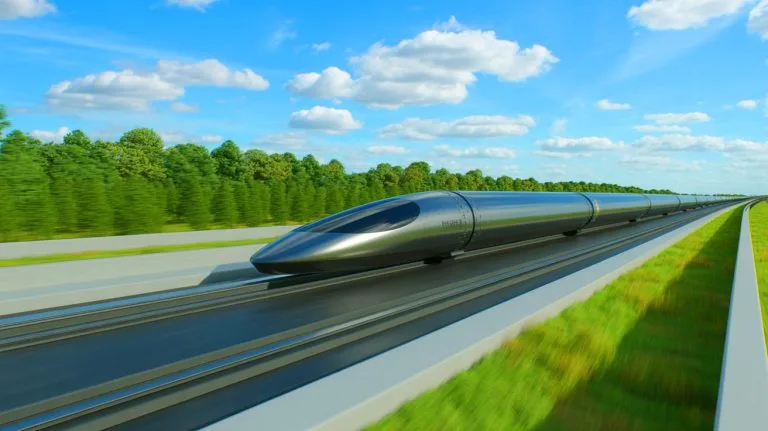| IN A NUTSHELL |
|
The future of transportation is taking shape in the Netherlands, where Hardt Hyperloop has reached a significant milestone. During recent tests at the European Hyperloop Center, this Dutch tech company showcased its cutting-edge hyperloop technology. Their vehicle reached a record speed of nearly 53 miles per hour while successfully performing a lane-switch maneuver. These achievements mark a pivotal moment in the development of hyperloop systems, not just in Europe, but globally. Hardt Hyperloop’s breakthrough hints at the potential of achieving even greater speeds, potentially reaching 435 miles per hour, in the near future.
Breaking Speed Records
The successful test conducted by Hardt Hyperloop involved a unique vehicle that accelerated at 0.3G on a 1,379-foot test track. The vehicle impressively reached a speed of 53 miles per hour within the first 460 feet of the track. The subsequent 509-foot section was where the vehicle executed the lane-switch maneuver, a critical feature for hyperloop systems. Finally, the vehicle came to a complete stop in the remaining 328 feet. This successful sequence not only set a new speed record but also showcased the feasibility of lane-switching at high speeds.
Demonstrating lane-switching at these speeds is a major leap from theoretical designs to real-world systems. This advancement is crucial for scalable hyperloop implementation worldwide. Unlike traditional systems, Hardt Hyperloop’s lane-switching mechanism features zero moving parts in the infrastructure. This design increases the reliability and capacity of the transportation network, addressing longstanding challenges in networkability, safety, and robustness. As Roel van de Pas, managing director at Hardt Hyperloop, remarked, this achievement is a major step forward in the evolution of hyperloop technology.
Next-Gen Mobility Arrives
Over 750 test missions have been carried out by Hardt Hyperloop since the initial tests at the European Hyperloop Center. These missions have led to several technological breakthroughs, including a motionless lane-switch mechanism and a safer magnetic levitation system. The company’s efforts have also resulted in a 45% reduction in bogie weight and a 50% increase in thrust. Hardt has integrated magnetic guidance with propulsion, removing perceived barriers to scaling the system to reach speeds of 435 miles per hour.
Kees Mark, managing director of the European Hyperloop Center, emphasized the significance of this achievement, stating it showcases European innovation and leadership in sustainable transport. Hardt Hyperloop’s roadmap includes plans for a demonstration route ranging from 1.9 to 3.1 miles, followed by an operational line extending 19 to 31 miles. These developments pave the way for commercial deployment and highlight Europe’s commitment to leading in next-generation transportation.
Global Interest in Hyperloop Technology
The global interest in hyperloop technology is gaining momentum. Countries like Italy, Germany, and India are actively exploring hyperloop routes, while China aims to launch a fully operational hyperloop corridor between Shanghai and Guangzhou by 2035. This international trend underscores the potential of hyperloop systems to revolutionize high-speed travel.
Italy has already approved a demonstration line between Venice and Padua, while Germany’s coalition agreement supports a pilot route. India is considering its own hyperloop projects, reflecting a broader global commitment to exploring sustainable and efficient transportation solutions. Hardt Hyperloop’s recent achievements serve as a catalyst for these developments, reinforcing the viability of hyperloop technology as a major player in the future of transportation.
Challenges and Opportunities Ahead
While the recent successes of Hardt Hyperloop are noteworthy, significant challenges remain. Hyperloop technology must continue to address issues related to scalability, safety, and integration with existing transportation networks. Additionally, building public trust and securing regulatory approvals are essential steps toward widespread adoption.
Nonetheless, the opportunities presented by hyperloop systems are vast. With the potential to significantly reduce travel times and carbon emissions, hyperloop technology offers a sustainable alternative to traditional transportation methods. As countries continue to invest in research and development, the global transportation landscape may soon be transformed by this innovative technology.
As Hardt Hyperloop and other pioneers push the boundaries of transportation, the world watches with anticipation. Will hyperloop systems redefine global travel in the coming decades, or will unforeseen challenges curtail their progress? The answer to these questions will shape the future of mobility worldwide.
Did you like it? 4.4/5 (30)






Wow, 53 MPH in a vacuum tube? 🚄 That’s impressive! How does it compare to other hyperloop systems?
Wow, 53 mph! 🚄 What’s the next milestone for Hardt Hyperloop?
What’s the environmental impact of building these hyperloop systems?
It’s amazing to see Europe leading the way in hyperloop tech! Go Hardt! 🇳🇱
Are there any plans for a hyperloop in the UK? We could really use an upgrade in public transport.
The future of travel looks bright! Thanks for the update. 😊